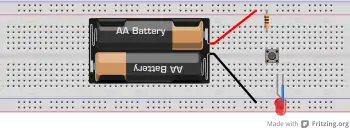Fritzing
Fritzing is an open-source initiative[3] to develop amateur or hobby CAD software for the design of electronics hardware, to support designers and artists ready to move from experimenting with a prototype to building a more permanent circuit. It was developed at the University of Applied Sciences Potsdam.[4]
 Fritzing's breadboard view | |
| Developer(s) | Interaction Design Lab Potsdam |
|---|---|
| Stable release | 0.9.4[1]
/ 1 December 2019 |
| Repository | |
| Operating system | Mac OS X, Unix, Windows |
| Type | EDA |
| License | GPLv3 (software) CC BY-SA (component images)[2] |
| Website | fritzing |
Goals

The software is created in the spirit of the Processing programming language and the Arduino microcontroller[5] and allows a designer, artist, researcher, or hobbyist to document their Arduino-based prototype and create a PCB layout for manufacturing. The associated website helps users share and discuss drafts and experiences as well as to reduce manufacturing costs.
Fritzing can be seen as an electronic design automation (EDA) tool for non-engineers: the input metaphor is inspired by the environment of designers (the breadboard-based prototype), while the output is focused on accessible means of production. As of December 2, 2014 Fritzing has made a code view option, where one can modify code and upload it directly to an Arduino device.[6]
Component images are distributed under CC-BY-SA, which will also be the license for any generated breadboard views.
 Breadboard view of a simple circuit, drawn with Fritzing. |
 Circuit diagram of the same circuit. |
Developer
The Fritzing source code is written in C++ using the Qt-framework. The source code can be downloaded and edited via the GitHub repositories. The source is split in two main repositories: Fritzing-App and Fritzing-Parts.
Maker
Fritzing allows for easy creation of printed circuit boards. FritzingFab enables users to order PCBs with designs made on the Fritzing software.
Additionally, the website contains a forum where users can share and comment on each other's designs.
See also
References
- "CD-498". Retrieved 6 December 2019.
- What license is Fritzing released under? FAQ
- McRoberts, Michael (2010). Beginning Arduino. APress. pp. xx. ISBN 978-1-4302-3240-7.
- Brühlmann, Thomas (2010). Arduino: Praxiseinstieg. Hüthig Jehle Rehm. p. 270. ISBN 978-3-8266-5605-7.
- Gläser, Thomas; Markus Jaritz; Philipp Sackl (13 September 2009). "Hardware-Hacking: So baut man einen Tentakel-Roboter für 100 Euro". Der Spiegel. Retrieved 14 April 2011.
- http://blog.fritzing.org/2014/12/02/its-fritzmas-new-fritzing-code-view-release-and-a-little-present.
External links
| Wikimedia Commons has media related to Fritzing. |
- Official website
- User Forum
- FabService
- Fritzing-App on GitHub
- Fritzing-Parts on GitHub
- Fritzing overview